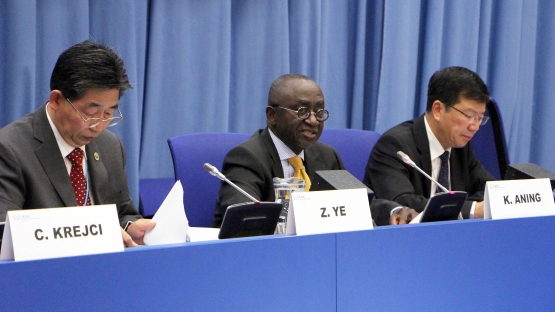A number of food scandals, including adulterated beef products with horse meat, contaminated milk, bacteria in fresh foods, and melamine, antibiotic and dioxin tainted products, have gripped global attention and highlighted the critical necessity to protect the consumer against food contamination issues that do pose a health risk. That is why food safety and security are paramount. Food safety relates to the production, handling, preparation, and storage and quality of food in ways that prevent foodborne illness, which includes tracking the food chain from its origins to when the product reaching the consumer. As such, it also contributes to food security, which is aimed at ensuring the ongoing availability of food.
Detecting unsafe food, fighting food fraud - the deliberate mislabelling of food products - and food irradiation are among the key issues that will be addressed this week at a gathering of international organizations, scientists, policy makers, experts and Member States delegates attending the FAO/IAEA International Symposium on Food Safety and Quality.
The Symposium, taking place from 10 to 13 November 2014 at IAEA Headquarters, covers a range of issues including the research and application of nuclear technology for agrifood safety; international efforts to improve food safety; using nuclear science and applications to track adulteration in food products; nuclear-physical methods for detecting pollutants and microelements in food; and effective nuclear techniques to assess and manage risks to protect the consumer.
Opening the Symposium, Kwaku Aning, IAEA Deputy Director General and Head of the Department of Technical Cooperation, highlighted the meeting’s purpose, which aimed “to contribute to a broader understanding of the techniques and issues involved in food safety and quality." His welcome address also emphasized the importance of food control as a "multidisciplinary field, where both nuclear techniques and conventional methods are necessary to ensure the safety and quality of food."
Deputy Director General Aning also spoke about the close collaboration between the Agency’s Department of Technical Cooperation and the Department of Nuclear Sciences and Applications in implementing the technical cooperation projects relating to food security and safety. In this context, he also mentioned the coordination and interaction with national authorities in Member States at every stage of the formulation, implementation and evaluation of a technical cooperation project.
Food contamination poses a food safety threat and can endanger human health. It can result in harmful illness such as salmonella and E.coli for which authorities need to have tools to detect, monitor and control these contaminants. Deputy Director General Aning also underscored the importance of tracing the origin of food products and contaminants, “in order to identify and implement corrective actions and to combat food fraud.”
Qu Liang, Director of the Joint FAO/IAEA Division of Nuclear Techniques in Food and Agriculture, in his speech spoke on the Joint Division’s 50 years partnership, which continues to work towards strengthening global food security and sustainable agricultural development. He stressed the importance to maintain and assure the safety and quality of food for humanity. He also noted that ensuring the integrity of the food supply is “of utmost importance in terms of food security, consumer protection and international trade.”
Director Liang highlighted that effective techniques are necessary to help assess and manage risks, and protect the consumer. The aim of the Joint FAO/IAEA Division was to continue to seek “synergies to develop and adapt nuclear techniques and related technologies to solve problems in the area of food and agriculture.” The Joint Division plays a pivotal role in the success of nuclear applications in food and agriculture. He also drew attention to other challenges to food issues such as climate change which has raised new concerns that call for innovative and improved food control measures.
Over the coming days, experts will provide detailed presentations on the various scientific methods available to test, protect and certify food produce and products. They will cover:
- Nuclear applications such as isotopic techniques being employed to fingerprint food and trace it to its source;
- Detecting and controlling contaminants;
- Food irradiation technology;
- How nuclear science and technology can complement and supplement existing technologies to ensure food security, safety and quality;
- The role of nuclear science and technology in sustaining agricultural development in developing countries; and
- An overview of the applications of radiation processing in combination with conventional treatments to assure food safety.
Determining the integrity of the food supply chain is key to ensuring its safety and quality, as well as protecting the consumer and promoting domestic and international trade.


